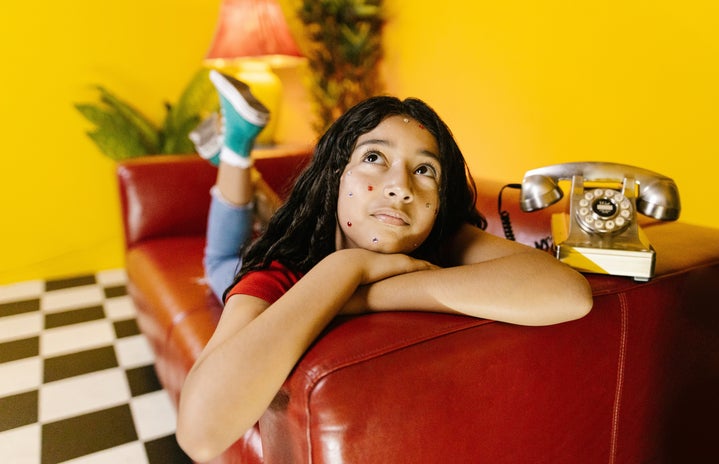As we approach winter, it’s important to switch out your hair routine for one that can withstand the harsh weather.
According to the book “Good Hair: The Essential Guide to Afro, Textured and Curly Hair” by Charlotte Mensah, kinky and curly hair types are more fragile and prone to damage than their straight counterparts.
Black people usually have kinky hair with tight coils. They also tend to have curly hair or a mix of both, which can make it easier to style.
Regardless of your race, or which curl type you have, it is more susceptible to damage in the winter months, which means it’s time to start taking extra care of it.
Testing Hair Porosity
Before taking any actual steps, the first thing you should do is check your hair’s porosity level.
To check your hair porosity, drop one strand into a glass of water.
Porosity is your hair’s ability to retain moisture. There are three levels to porosity — low, medium and high.
If your strand stays floating at the top, you have low porosity hair. If it sinks quickly, the hair is high porosity. Hair that floats temporarily then sinks to the bottom is an indication of medium porosity hair.
If your hair is medium or high porosity, you will have an easier time retaining moisture therefore having an easier time maintaining the integrity of your hair.
If you have low porosity, which is common for black hair, then you have to take a few extra steps to ensure your hair shaft retains moisture. Avoid conditioners that include protein as an ingredient, it fills the holes in your hair shaft which blocks moisture. Instead, steam treat or use a plastic cap while you condition your hair will help the products penetrate easier.
Now that you understand the physical properties of your hair, it’s time to start your routine.
Your curly hair routine will start a few hours before you plan to wash it. Comb through your hair, in sections if it’s easier, and braid each section when it’s detangled to keep it tangle-free.
- Using Oils
-
This step is optional, but if your hair is lacking luster try starting with a hot oil treatment. You should only do these on a need basis because using too much oil in your hair over time can cause damage.
The optimal choice for a hot oil treatment is castor oil. It has a strong odor, so the best time to use it would be right before washing.
Alternatively coconut, rosemary, argan, vitamin e, olive, grapeseed or amla oil work well. After applying the oil of your choice, cover your hair with a plastic cap. You can expedite the process by sitting under a hooded dryer for 5 to 30 minutes, depending on your hair’s porosity, but the heat from your scalp under the plastic cap will still benefit your hair if you just leave it covered for 30 minutes.
- Wash Your Hair
-
Whether or not you choose to try a hot oil treatment, the next step is going to be washing your hair thoroughly. It’s important, especially for individuals with low porosity hair, to wash the built-up products and dirt from your hair. Product buildup can block your hair from growing or further damage it.
Once your hair is washed, condition, and then another optional step is a second deep conditioner. Use one with penetrating ingredients for as long as you desire. Just note that leaving your hair covered and wet with a treatment in it for extended periods of time can start to smell mildew-y and eventually grow mold.
It’s important to ensure your hair is completely rinsed before proceeding with your curly hair routine. Hair products work to their best ability on clean hair, so they can properly penetrate the hair shaft. If it’s blocked by conditioner, the products can’t do their job.
- Adding Additional Products
-
Apply your favorite products in small sections. Small sections ensure that your hair is fully saturated with product.
Choosing products can be intimidating, but trial-and-error is the only way to find the perfect products for your hair. Avoid products with ingredients like mineral oil, which is just filler that sits on top of your hair, or alcohol which dries curls out.
For weeks that you want to wear your hair curly, you will want to choose a moisturizing product and a styling product to achieve the best results.
For moisturizing products, there are leave-in conditioners, creams, or hair grease. These should be applied first in your hair routine.
You should use a mousse, gel, shea butter or styling cream as a styling product. They go on top of your moisturizing product and act as a sealant to lock your style in place.
I suggest only using one of each: a moisturizing product and a styling product to minimize product buildup.
- Styling Your Hair
-
It’s not just about what you do at home to take care of your hair. How you wear your hair can be a factor in keeping your hair healthy.
If you want to avoid putting heat on your hair, ou can try braid-outs, twist-outs, or a wash and go to leave it curly.
In the winter, I suggest leaving your twists or braids in for a week so they can properly set in place, and it gives your hair a break before constantly manipulating and styling it while it’s out. I call this “recovery week” for my hair. I suggest oiling your scalp and ends nightly for maintenance.
Bantu knots, perm or flexible rods, or roller sets are other curl methods that are going to stretch your hair and last longer, but they need to set with heat for the best results. I recommend blow drying your hair on low heat with minimal tension to start.
There are a plethora of protective styles you can try for the winter. Keeping your hair in low tension styles like loose buns, ponytails or claw clips are examples of protective styles. The most important part of styling your hair in the winter is protecting the ends of your hair, and being gentle with the hair around your hairline.
The most important part of taking care of your hair for the winter is retaining moisture and keeping the ends of your hair protected. Try low tension or protective styles to keep your hair protected between washes.


